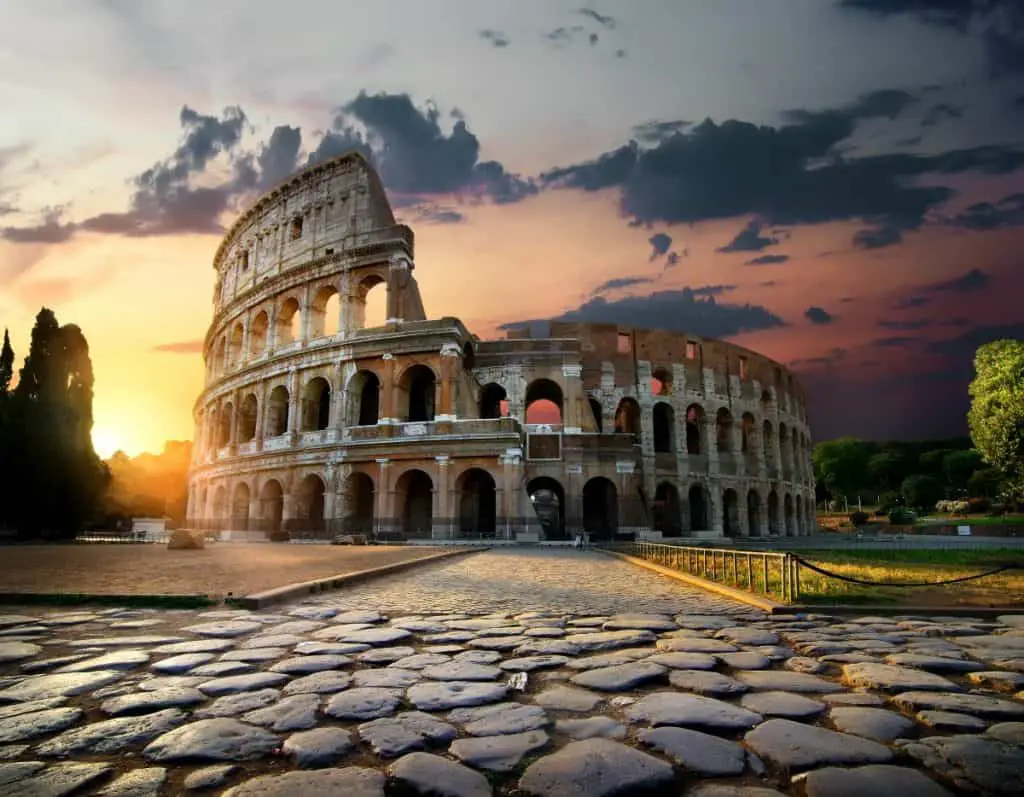Concrete has a long history. Since its discovery over many thousands of years, concrete has evolved, adapted to change, been lost to dark ages, and rediscovered again. Concrete has proven itself to be one of the most common and essential ingredients to the building of both Eastern and Western civilizations and recent studies have even shown it to be older than civilization as we know it.
The invention of concrete came about as early as 6500 B.C. Stone age Bedouins or Nabataean traders in southern Syria and northern Jordan built the first structures using hydraulic lime. They discovered that certain types of lime can set using water and used it to create houses, floors, and cisterns.

If you’re like me and you’re excited about the history and evolution of concrete, below is a detailed timeline and complete history of concrete from its inception in the stone age to its modern usage in towering buildings.
Table of Contents
6500 B.C.E – 5600 B.C.E
First, I should distinguish between cement and concrete. Cement is a binding agent that is made from clay, limestone, and calcium. By itself, however, cement can break. Mixing cement with water, rocks, and sand turns it into the stronger material of concrete.

The first crude use of concrete came about when peoples of ancient Syria and Jordan discovered the certain limes could set and harden when just enough water was added to it. They lived on natural deposits of cement compounds that had been formed millions of years before when limestone and oil shale reacted together to form cement.
Since the cement is just one ingredient to concrete, early builders would add other materials in with the cement such as water, stones, and silica sand. These “aggregates,” as they’re called, were used to create living structures such as homes and buildings, as well as many underground cisterns throughout the desert.
Some of those old cement cisterns still survive today, many were kept secret and have become lost. But the Nabataeans were smart enough to make their cement waterproof as well, combining the lime with pozzolan sand and then heating it in a kiln.
The creation and use of this cement presumably spread from the Middle East into the west into the area that was once Yugoslavia. Excavations around the Danube River in the 1960s uncovered several huts that used concrete in the flooring. The concrete mixed lime with the aggregates gravel, sand, and water, similar to our modern concrete. Source
3000 – 2500 B.C.E
The next instance of nuanced use of concrete comes from two countries from altogether different continents: Egypt and China.
Firstly, Egypt mostly used mud and straw to create bricks when building large structures. Mud and straw, as we know from our definition, does not create concrete.

During the type of the Early Dynastic Period (c. 3150 – 2686 B.C.E) when the Egyptians were building the first pyramids, they began to use gypsum and lime mortars in their construction. It can (and has) been argued that mortar and concrete are two different materials altogether, and the arguments continue today.
Regardless, the Great Pyramid of Giza is said to have used at least 500,000 tons of mortar used to hold the limestone blocks together. Historians believe that the limestone was hauled from nearby quarries nearby. How that limestone was hauled is still a matter of debate.
At the same time, the Chinese had also come up with a unique and unexpected form of concrete used in building both bamboo boats and the Great Wall. This is known as “sticky rice mortar.” The Chinese mixed sticky rice soup with slaked lime and created a composite mortar that was stronger and more waterproof than lime mortar.
In addition to boats and the Great Wall, the sticky rice mortar would later be used to maintain the durability of city walls, tombs, pagodas. This type of mortar was used because unlike the Bedouins, the Chinese did not have access to hydraulic mortar.
800 B.C.E – 500 C.E

Much later, the Greeks discovered the use of pozzolan materials mixed with lime and laid the foundation for the famous Roman concrete. The Greeks used this mix on their floors, foundations, and sewers. Far from being a footnote in Western history, the Greeks (along with the Minoan civilization) can be credited for introducing this type of concrete to Western history.
However, Greeks did not use concrete and mortars to the extent that the Romans did. In fact, the Greek mortars were much harder than Roman concrete. The Romans tended to steal from the Greeks and other cultures and claim it as their own.
Roman engineers, by about 200 B.C.E, were using concrete in a way that had never been seen before and in a more widespread way that they would be famous for thousands of years later.
The way the Romans used cement was much different than how we use it today. They took stones of various sizes and would use the mortar to fill in the gaps. They would use lime, water, and volcanic ash (pozzolan) to create the mix, then pack the mix into wooden forms. The set blocks would then be used as bricks.
When the Romans created molds, they could pour the mixture and create structures like arches and domes. You might be familiar with the structure of the Colosseum which was created with concrete and commissioned by Emperor Vespasian almost 2,000 years ago. It’s just one example of many.
Overall, Roman architecture has survived and weathered time so well because of their engineers’ expert ingenuity with concrete. Without it, we wouldn’t have structures such as the Roman Pantheon still standing today. It’s incredible what the Romans accomplished with their primitive cement mixtures before Portland cement was discovered. Source
500 C.E – 1500 C.E
The Middle Ages were a time of loss and decline. After the Roman Empire split into two sides: the Western and the Eastern sides, it was the beginning of the end of the golden age of concrete. Things began to fall apart after the Roman Empire fell in 476 C.E.
The loss of concrete contributed to the lack of pozzolan materials, inadequate mixing, and low kiln temperatures for burning lime. Those grand techniques for creating concrete that built empires were lost for hundreds of years.

In the early 15th century, the interest in creating concrete with cement was rekindled when manuscripts were found that detailed how to create it. Slowly, humanity had to relearn the important things we used to know, and it would be a few hundred more years until we mastered concrete again.
1500 C.E – 1900 C.E
In 1756, a British engineer by the name of John Smeaton started the construction of what would eventually become known as “Smeaton’s Tower,” and was really a reconstruction of a former lighthouse.
It was Smeaton who rediscovered the use of hydraulic lime that hadn’t been used since Roman times. The reconstruction took approximately three years to complete. In August of 1759, it became a lighthouse on the Eddystone Reef in Devon, England.

The next significant invention would take place in 1824 when Joseph Aspdin invented Portland Cement, which is a high-quality cement that was made from ground chalk and clay that were burned, thus removing any carbon dioxide.
Portland cement is named because of the resemblance to the stone that was quarried from the Island of Portland in Dorset, England. Later, Joseph’s son, William, would develop the cement into something resembling our modern Portland cement, which is now used all over the world.
Because of its low-cost and versatility, Portland cement would become one of the most widespread materials used in construction over the past few centuries. Europeans would begin concrete mixed with Portland cement in the construction of their industrial buildings at first and later in homes and castles.
In 1891, an American inventor by the name of George Bartholomew poured and laid the first cement pavement street in Bellefontaine, Ohio. He used limestone and clay found in the immediate area and has been credited with building the first “artificial stone” for paving streets.
1900 C.E – 2020 C.E
During the nineteenth century, the use of concrete in the building of large structures increased exponentially. Not only that but using steel-reinforced concrete became widely used throughout developed countries like Europe and the United States.
Because building homes using concrete was not as “socially” or “aesthetically” acceptable, designers of buildings had to get creative. In 1902, the Frenchman Auguste Perret designed an aesthetically pleasing and steel-reinforced apartment building in Paris. The design soon spread throughout the world.
Concrete began to be used in high rise office buildings, bridges, airport hangars, and dams. Much like the Romans of old, modern engineers could now use their nuanced methods of mixing and reinforcing concrete to build structures like arches, domes, and roofs.
In 2011, the largest structure using reinforced concrete was built in Dubai: the Burj Khalifa. It stands 2,717 feet tall and has used 431,600 cubic yards of concrete with over 61,000 tons of rebar. It weighs about 500,000 tons (which, if you remember, was the same amount of mortar used in the Great Pyramid of Giza).

Today, concrete has become a science and an art. The invention and rediscovery of concrete mixing methods cannot be overstated and has been one of the building blocks of modern civilization. Using Earth’s chemistry, engineers can build structures that are only limited by our imagination.



